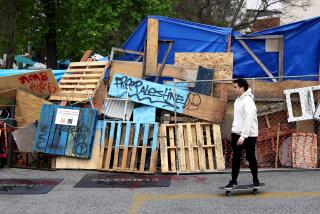Cal State San Marcos Sets Its Sights on the World : Education: Faculty members at the new state university adopt a mission statement that emphasizes liberal arts and a global outlook.
The new state university in San Marcos will make its mark with an international focus while steeping its students in liberal arts, according to a statement adopted Thursday that outlines the founding faculty’s vision for the institution.
The statement avoids specifics and was adopted after some consternation among the faculty over how clear-cut the university’s science agenda should be.
One feature was the aim for a global outlook.
The university “endorses an international perspective that addresses the global community in social, political and economic terms,” the document reads. “This multicultural outlook is reflected in our curriculum, extracurricular activities, international exchanges and special programs that focus on world issues and problems. We prepare students to take leadership roles in areas of work and society in the international community of the 21st Century.”
Although the statement doesn’t get more specific, faculty members note that, already, two international research centers are being established on the campus. One, headed by Prof. William Liu, will study gerontology among Asians. The other, headed by Prof. Isabel Schon, will study Spanish-language literature for children.
“Consistent with its global orientation, the university exposes students to the study of languages, to world literature and the fine arts, and to issues and traditions of the United States and other countries,” the statement continues. To that end, faculty members say, students in a variety of majors will probably be required to take a year’s study in a foreign language for graduation.
But the faculty also was in strong agreement that Cal State San Marcos should evolve as a “user-friendly” campus more like a small college than the sprawling, commuter campus it will one day become.
The mission statement will now be forwarded to university President Bill Stacy, who indicated Thursday that he may strengthen the science emphasis but who otherwise said he was delighted by the faculty’s philosophy.
“The people who will first look to it for guidance will be me and the faculty, because it will be the foundation on which we’ll build, and the measurer for the kinds of programs that will be considered here,” Stacy said. “We’ll use this mission statement in recruiting new faculty, by showing it to them and asking them if this is the kind of place where they can be comfortable.”
The 20th Cal State university, operating out of leased offices in San Marcos, will hold its first classes next fall for juniors and graduate students, and will expand to accept seniors in the fall of 1991. Freshmen will be admitted in fall of 1995. The first permanent campus buildings are scheduled to open in the fall of 1992.
Only the founding 12 faculty members are on board at Cal State San Marcos; 20 more will be hired before next fall. Majors have not yet been adopted, but tentative choices include biology, business accounting, business management, history, liberal studies, mathematics, psychology and sociology.
Adopting the mission statement is part of the protocol of establishing a university, intended to offer students and the community a sense of the institution’s philosophy and broad-brush objectives.
The 12 faculty members deliberated over the statement two months and pored over nine revisions before adopting the final draft Thursday, which concluded:
“The goal of California State University, San Marcos, is to instill in its students the enthusiasm and curiosity, the creativity and originality, the healthy skepticism and the habit of continuing inquiry that are central to all truly educated men and women.”
According to the statement, the university “expects a high level of academic scholarship in research and teaching, and protects academic freedom requisite to such scholarly pursuits.”
Outside the classroom, the university will offer “cultural enrichment in an intellectually stimulating environment” and serve “as a focus for community social activities, art, music and sporting events.”
The two-page document calls for the university to be responsive to its students and the North County community as a whole, but says the institution will look beyond Southern California in preparing students.
Perhaps the most ticklish issue in developing the statement was defining to what degree the university will pursue the sciences--a favorite subject among North County business and industrial leaders who say they hope the new campus will generate young, new scientists.
Much debate on Thursday, for instance, focused on the proposed statement: “The university stimulates scientific research and development in collaboration with public and private organizations in the area, and serves as a resource for books, ideas, computing and other technology.”
Around a conference table, some professors suggested that the word “scientific” be dropped because it was suggested that the university would not pursue research and development in non-scientific areas.
Larry Cohen, a molecular geneticist, cringed. “Doesn’t it diminish the significance of science if we leave it out?” he asked. It was, however, dropped from the sentence, and the only one siding with Cohen was K. Brooks Reid, a mathematician.
More to Read
Sign up for Essential California
The most important California stories and recommendations in your inbox every morning.
You may occasionally receive promotional content from the Los Angeles Times.










